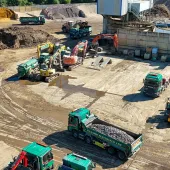Fraunhofer Institute creates new process for recycling construction waste

German research organization says breakthrough in recycling could help meet building material shortage
WITH a construction boom underway in some European markets, raw materials are being placed under more and more supply pressure while the environmental damage wrought by the leftovers of building projects is ever-present.
In the past three years, Germany’s Fraunhofer Institute has been developing a ‘compromise solution’ to these problems as part of a €3.3 million research project which, according to the organization, has yielded promising results.
With around 5 million metric tons of fine-grained building rubble left behind during construction work in Germany each year, some of the key aims of the research project were to prevent this demolished material going to landfill sites and develop the ‘BauCycle’ process, which upcycles the waste into high-quality construction materials.
During the recovery process, rubble and other waste materials are sorted down to 1mm. And researchers at Fraunhofer Institute have developed an opto-pneumatic detector that allows fine fractions to be separated on the basis of the colour, brightness and chemical composition of the particles, including distinguishing sulphate from silicates.
Fraunhofer Institute claims up to four clean aggregates can be recycled and reused to produce aerated concrete – a light building material featuring good thermal insulation properties – suitable for building two-storey houses and used as indoor insulation.
Another key development of the process was that a combination of bricks and recovered concrete can be used to make geopolymers – a cement-free building material that is strong and acid-resistant, similar to concrete. Geopolymers also have an advantage of delivering a very low carbon footprint for the end-user.
In addition, further research by Fraunhofer Institute has yielded a prototype of a sound-absorbing, open-pored panel made of granulates, which matches up to current market materials for sound absorption.
‘The Fraunhofer Institutes have been involved in a huge number of technological breakthroughs across industry in 2018,’ said Robert Herrmann, chief executive officer for Germany Trade & Invest.
‘Germany has become a place of innovation, where future solutions can be found and where solid investment in the future is rewarded. This breakthrough success in the construction industry is a perfect example of how Germany’s R&D landscape rewards shrewd investment.’









